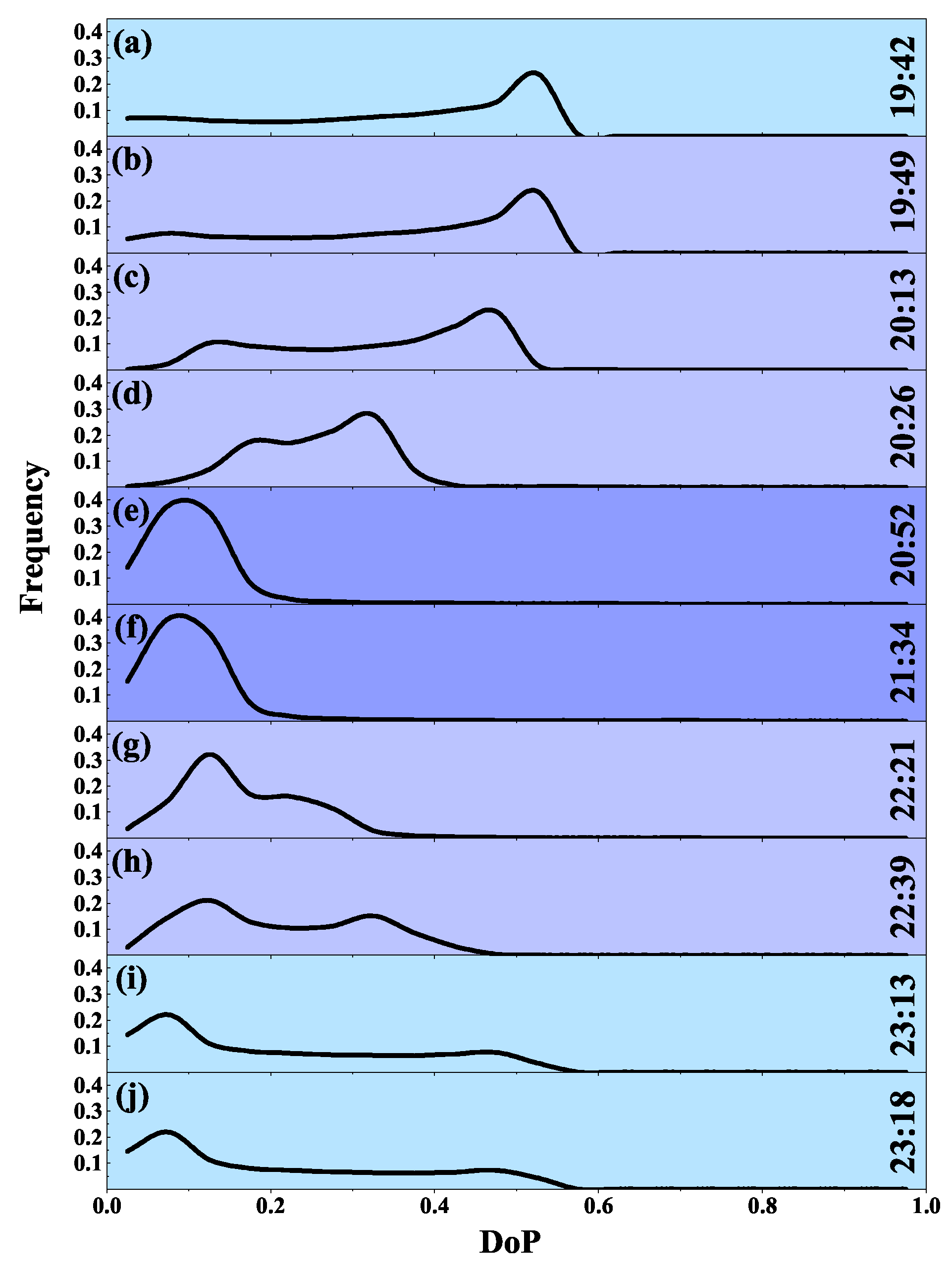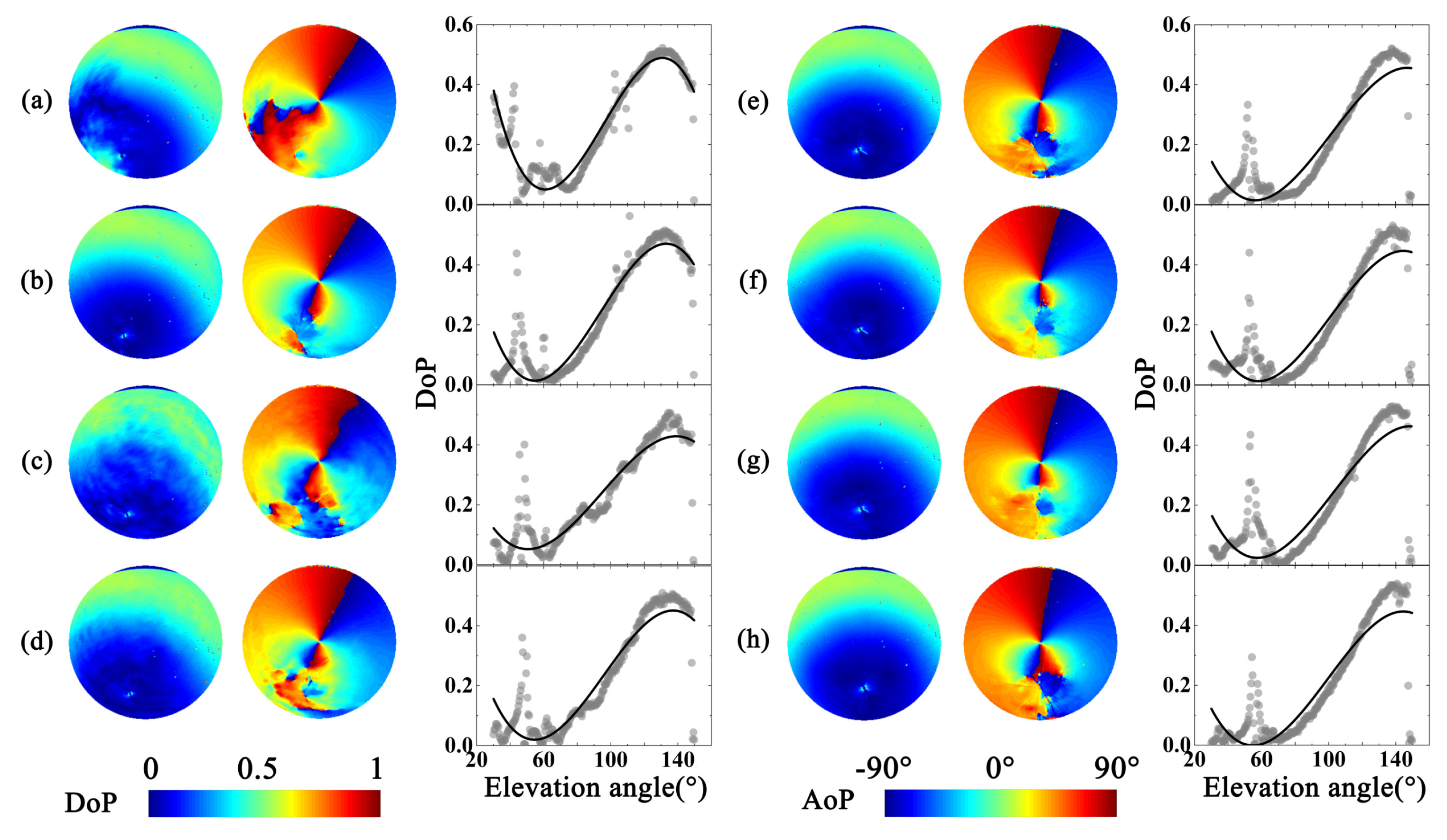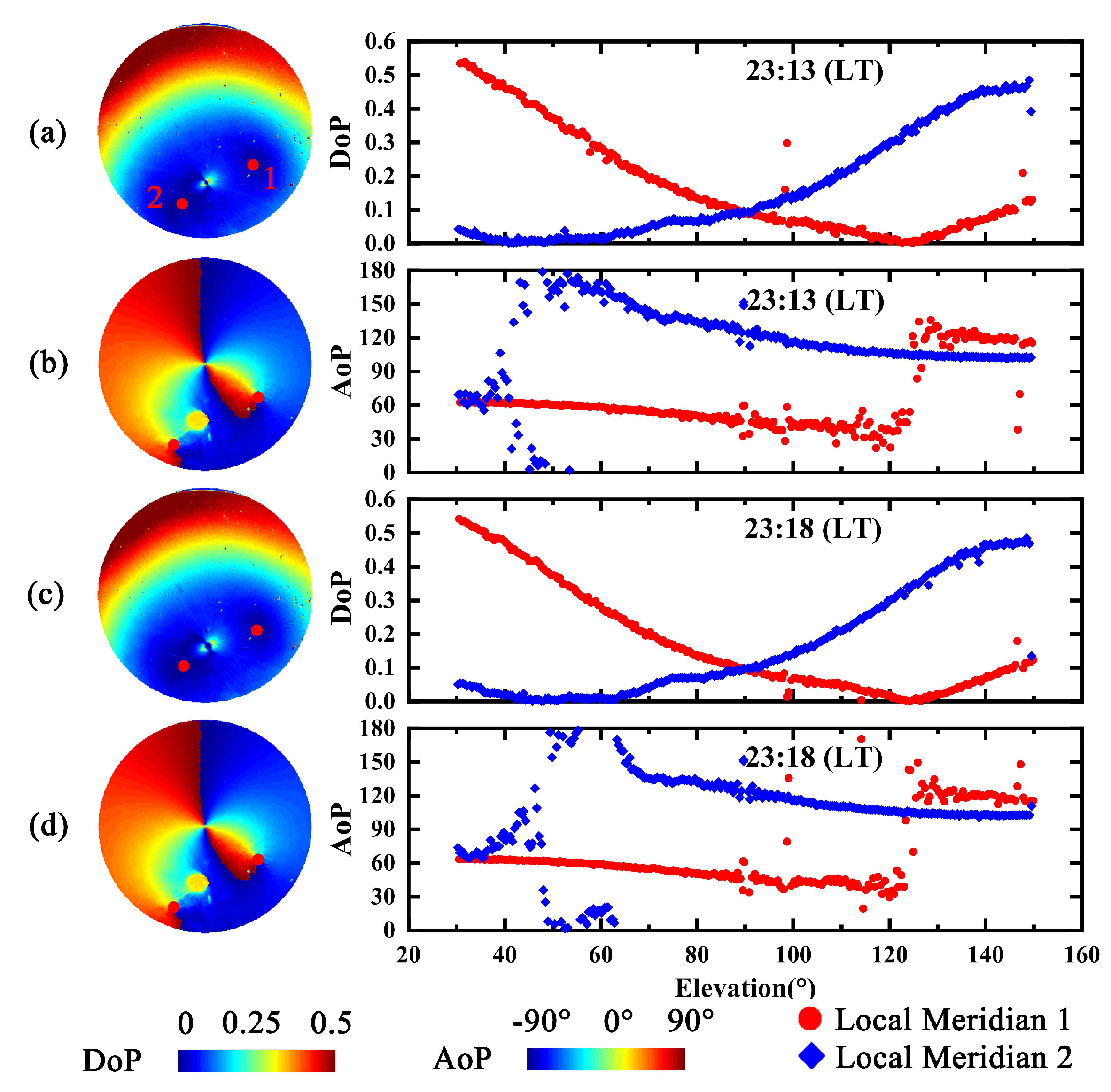Clear Night Sky Polarization Patterns Under the Super Blue Blood Moon
Abstract
1. Introduction
2. Methods and Experiments
2.1. Experiments
2.2. Methods
2.2.1. Skylight Polarization Calculations
2.2.2. Neutral Points Recognition
3. Results and Discussion
3.1. Variation of Polarization Patterns During SBBM
3.1.1. DoP Changes During Eclipse
3.1.2. AoP Changes During Eclipse
3.2. Comparison of SBBM and Normal Sky Polarization Patterns
- The symmetric line along the lunar-anti-lunar meridian approximated a straight line in the polarization patterns of the normal night sky at the lunar elevation from to during the measurement. In this elevation range, a point with uncertain directions off the lunar-anti-lunar meridian in the AoP does not appear in Figure 4. However, during the SBBM night, the symmetric line started to deviate from the meridian at of lunar elevation, and the point with uncertain directions in AoP gradually appeared during the course of elevation from to , reaching total clarity at .
- The lowest DoP area is on the right of lunar-anti-lunar meridian at of the lunar elevation in Figure 1g. However, this does not exist in Figure 4f,g at the same lunar elevation. Additionally, the lowest DoP area is on the right of the meridian at lunar elevation (Figure 1h), but there is no such area at similar lunar elevation of normal sky (Figure 4h).
- The distribution of the DoP gradually concentrated on a lower DoP during the partial eclipse and then converged to values below 0.2 during the total eclipse. In contrast, the distribution of the DoP in the normal sky was more stable.
- Both situations suffered from moonlight disturbance. On the lunar-anti-lunar meridian, the lowest DoP in the normal sky always approached zero. In contrast, the lowest DoP during the lunar eclipse was equal to zero only when the Moon was in the penumbra. This could also be seen in the normal sky Ratio(DoP < 0.05), which was greater than 15% (Figure 5), with the exception of cloud disturbance (Figure 5a–c). Furthermore, the Ratio(DoP < 0.05) of the normal sky was bigger than that during the partial eclipse. The maximum DoP was stable at 0.5 in normal sky, while during the eclipse, the maximum of DoP decreased as the percent obscuration increased.
3.3. Characteristic Analyses of Neutral Points During the Eclipse
4. Conclusions
Supplementary Materials
Author Contributions
Funding
Acknowledgments
Conflicts of Interest
Abbreviations
| SBBM | Super Blue Blood Moon |
| AoP | Angle of Polarization |
| DoP | Degree of Polarization |
| LT | Local Time |
| UTC | Coordinated Universal Time |
| GNSS | Global Navigation Satellite System |
References
- Bech, M.; Homberg, U.; Pfeiffer, K. Receptive fields of locust brain neurons are matched to polarization patterns of the sky. Curr. Biol. 2014, 24, 2124–2129. [Google Scholar] [CrossRef] [PubMed]
- Evangelista, C.; Kraft, P.; Dacke, M.; Labhart, T.; Srinivasan, M.V. Honeybee navigation: Critically examining the role of the polarization compass. Philos. Trans. R. Soc. B 2014, 369, 12. [Google Scholar] [CrossRef] [PubMed]
- Thorpe, W.H. Orientation and Methods of Communication of the Honey Bee and its Sensitivity to the Polarization of the Light. Nature 1949, 164, 11. [Google Scholar] [CrossRef] [PubMed]
- Rossel, S.; Wehner, R. Polarization vision in bees. Nature 1986, 323, 128. [Google Scholar] [CrossRef]
- Greif, S.; Borissov, I.; Yovel, Y.; Holland, R.A. A functional role of the sky’s polarization pattern for orientation in the greater mouse-eared bat. Nat. Commun. 2014, 5, 4. [Google Scholar] [CrossRef]
- Dacke, M.; Doan, T.A.; O’Carroll, D.C. Polarized light detection in spiders. J. Exp. Biol. 2001, 204, 2481–2490. [Google Scholar]
- Dacke, M.; Nilsson, D.E.; Warrant, E.J.; Blest, A.D.; Land, M.F.; O’Carroll, D.C. Built-in polarizers form part of a compass organ in spiders. Nature 1999, 401, 470. [Google Scholar] [CrossRef]
- Dacke, M.; Byrne, M.J.; Scholtz, C.H.; Warrant, E.J. Lunar orientation in a beetle. Proc. R. Soc. B 2004, 271, 361–365. [Google Scholar] [CrossRef]
- Dacke, M.; Nilsson, D.E.; Scholtz, C.H.; Byrne, M.; Warrant, E.J. Animal behavior: Insect orientation to polarized moonlight. Nature 2003, 424, 33. [Google Scholar] [CrossRef]
- Wehner, R. Desert ant navigation: How miniature brains solve complex tasks. J. Comp. Physiol. A 2003, 189, 579–588. [Google Scholar] [CrossRef]
- Fan, C.; Hu, X.P.; Lian, J.X.; Zhang, L.L.; He, X.F. Design and Calibration of a Novel Camera-Based Bio-Inspired Polarization Navigation Sensor. IEEE Sens. J. 2016, 16, 3640–3648. [Google Scholar] [CrossRef]
- Tang, J.; Zhang, N.; Li, D.; Wang, F.; Zhang, B.; Wang, C.; Shen, C.; Ren, J.; Xue, C.; Liu, J. Novel robust skylight compass method based on full-sky polarization imaging under harsh conditions. Opt. Express 2016, 24, 15834–15844. [Google Scholar] [CrossRef]
- Alexandrov, M.D.; Cairns, B.; Emde, C.; Ackerman, A.S.; van Diedenhoven, B. Accuracy assessments of cloud droplet size retrievals from polarized reflectance measurements by the research scanning polarimeter. Remote. Sens. Environ. 2012, 125, 92–111. [Google Scholar] [CrossRef]
- Fomin, B.; Falaleeva, V. A polarized atmospheric radiative transfer model for calculations of spectra of the stokes parameters of shortwave radiation based on the line-by-line and Monte Carlo methods. Atmosphere 2012, 3, 451–467. [Google Scholar] [CrossRef]
- Yang, J.; Du, T.; Niu, B.; Li, C.; Qian, J.; Guo, L. A Bionic Polarization Navigation Sensor Based on Polarizing Beam Splitter. IEEE Access 2018, 6, 11472–11481. [Google Scholar] [CrossRef]
- Tan, S.; Zhang, X.; Shi, G. MODIS Cloud Detection Evaluation Using CALIOP over Polluted Eastern China. Atmosphere 2019, 10, 333. [Google Scholar] [CrossRef]
- De Oliveira, A.M.; Souza, C.T.; de Oliveira, N.P.; Melo, A.K.; Lopes, F.J.; Landulfo, E.; Elbern, H.; Hoelzemann, J.J. Analysis of Atmospheric Aerosol Optical Properties in the Northeast Brazilian Atmosphere with Remote Sensing Data from MODIS and CALIOP/CALIPSO Satellites, AERONET Photometers and a Ground-Based Lidar. Atmosphere 2019, 10, 594. [Google Scholar] [CrossRef]
- Harrington, D.M.; Kuhn, J.R.; Ariste, A.L. Daytime sky polarization calibration limitations. J. Astron. Telesc. Instrum. Syst. 2017, 3, 018001. [Google Scholar] [CrossRef][Green Version]
- Bhandari, P.; Voss, K.J.; Logan, L.; Twardowski, M. The variation of the polarized downwelling radiance distribution with depth in the coastal and clear ocean. J. Geophys. Res. Ocean. 2011, 116. [Google Scholar] [CrossRef]
- Xu, Z.; Yue, D.K.; Shen, L.; Voss, K.J. Patterns and statistics of in-water polarization under conditions of linear and nonlinear ocean surface waves. J. Geophys. Res. Ocean. 2011, 116. [Google Scholar] [CrossRef]
- Barta, A.; Farkas, A.; Szaz, D.; Egri, A.; Barta, P.; Kovacs, J.; Csak, B.; Jankovics, I.; Szabo, G.; Horvath, G. Polarization transition between sunlit and moonlit skies with possible implications for animal orientation and Viking navigation: Anomalous celestial twilight polarization at partial moon. Appl. Opt. 2014, 53, 5193–5204. [Google Scholar] [CrossRef]
- Cronin, T.W.; Warrant, E.J.; Greiner, B. Celestial polarization patterns during twilight. Appl. Opt. 2006, 45, 5582–5589. [Google Scholar] [CrossRef]
- Horvath, G.; Barta, A.; Gal, J.; Suhai, B.; Haiman, O. Ground-based full-sky imaging polarimetry of rapidly changing skies and its use for polarimetric cloud detection. Appl. Opt. 2002, 41, 543–559. [Google Scholar] [CrossRef]
- Shaw, G.E. Sky brightness and polarization during the 1973 African eclipse. Appl. Opt. 1975, 14, 388–394. [Google Scholar] [CrossRef]
- Chen, W.; Bai, S.; Wang, D.; Zhao, H.; Li, Z. Aerosol-induced changes in sky polarization pattern: Potential hint on applications in polarimetric remote sensing. Int. J. Remote Sens. 2019, 1–18. [Google Scholar] [CrossRef]
- Hasekamp, O.P.; Litvinov, P.; Butz, A. Aerosol properties over the ocean from PARASOL multiangle photopolarimetric measurements. J. Geophys. Res. 2011, 116. [Google Scholar] [CrossRef]
- Gao, M.; Zhai, B.A.P.W.; Franz, Y.H.; Knobelspiesse, P.K.; Werdell, J.; Ibrahim, A.; Cairns, B.; Chase, A. Inversion of Multiangular Polarimetric Measurements over Open and Coastal Ocean Waters: A Joint Retrieval Algorithm for Aerosol and Water-leaving Radiance Properties. Atmos. Meas. Tech. 2019, 12, 3921–3941. [Google Scholar] [CrossRef]
- Wang, H.; Yang, L.; Zhao, M.; Du, W.; Liu, P.; Sun, X. The Normalized Difference Vegetation Index and Angular Variation of Surface Spectral Polarized Reflectance Relationships: Improvements on Aerosol Remote Sensing Over Land. Earth Space Sci. 2019, 6, 982–989. [Google Scholar] [CrossRef]
- Zhao, H.; Xu, W.; Zhang, Y.; Li, X.; Zhang, H.; Xuan, J.; Jia, B. Polarization patterns under different sky conditions and a navigation method based on the symmetry of the AOP map of skylight. Opt. Express 2018, 26. [Google Scholar] [CrossRef]
- Gál, J.; Horváth, G.; Meyer-Rochow, V.B.; Wehner, R. Polarization patterns of the summer sky and its neutral points measured by full-sky imaging polarimetry in Finnish Lapland north of the Arctic Circle. Proc. R. Soc. Lond. Ser. A Math. Phys. Eng. Sci. 2001, 457, 1385–1399. [Google Scholar] [CrossRef]
- Hegedüs, R.; Åkesson, S.; Wehner, R.; Horváth, G. Could Vikings have navigated under foggy and cloudy conditions by skylight polarization? On the atmospheric optical prerequisites of polarimetric Viking navigation under foggy and cloudy skies. Proc. R. Soc. A Math. Phys. Eng. Sci. 2007, 463, 1081–1095. [Google Scholar] [CrossRef]
- Hegedüs, R.; Åkesson, S.; Horváth, G. Polarization patterns of thick clouds: Overcast skies have distribution of the angle of polarization similar to that of clear skies. J. Opt. Soc. Am. A 2007, 24, 2347–2356. [Google Scholar] [CrossRef] [PubMed]
- Gál, J.; Horváth, G.; Barta, A.; Wehner, R. Polarization of the moonlit clear night sky measured by full-sky imaging polarimetry at full Moon: Comparison of the polarization of moonlit and sunlit skies. J. Geophys. Res. 2001, 106, 22647–22653. [Google Scholar] [CrossRef]
- Kyba, C.C.; Ruhtz, T.; Fischer, J.; Hölker, F. Lunar skylight polarization signal polluted by urban lighting. J. Geophys. Res. 2011, 116. [Google Scholar] [CrossRef]
- Guan, L.; Li, S.; Zhai, L.; Liu, S.; Liu, H.; Lin, W.; Cui, Y.; Chu, J.; Xie, H. Study on skylight polarization patterns over the ocean for polarized light navigation application. Appl. Opt. 2018, 57, 6243–6251. [Google Scholar] [CrossRef]
- Pomozi, I.; Gal, J.; Horvath, G.; Wehner, R. Fine structure of the celestial polarization pattern and its temporal change during the total solar eclipse of 11 August 1999. Remote Sens. Environ. 2001, 76, 181–201. [Google Scholar] [CrossRef]
- Horváth, G.; Pomozi, I.; Gál, J. Neutral points of skylight polarization observed during the total eclipse on 11 August 1999. Appl. Opt. 2003, 42, 465–475. [Google Scholar] [CrossRef][Green Version]
- Sipöcz, B.; Hegedüs, R.; Kriska, G.; Horváth, G. Spatiotemporal change of sky polarization during the total solar eclipse on 29 March 2006 in Turkey: Polarization patterns of the eclipsed sky observed by full-sky imaging polarimetry. Appl. Opt. 2008, 47, H1–H10. [Google Scholar] [CrossRef]
- Usman, K.A.; Habersetzer, J.; Subbaraj, R.; Gopalkrishnaswamy, G.; Paramanandam, K. Behaviour of bats during a lunar eclipse. Behav. Ecol. Sociobiol. 1980, 7, 79–81. [Google Scholar] [CrossRef]
- Singaravelan, N.; Marimuthu, G. Moonlight inhibits and lunar eclipse enhances foraging activity of fruit bats in an orchard. Curr. Sci. 2002, 82, 1020–1022. [Google Scholar]
- Donati, G.; Lunardini, A.; Kappeler, P.; Borgognini Tarli, S. Nocturnal activity in the cathemeral red-fronted lemur (Eulemur fulvus rufus), with observations during a lunar eclipse. Am. J. Primatol. 2001, 53, 69–78. [Google Scholar] [CrossRef]
- Tarling, G. The effect of lunar eclipse on the vertical migration behavior of Meganyctiphanes norvegica (Crustacea: Euphausiacea) in the Ligurian Sea. J. Plankton Res. 1999, 21, 1475–1488. [Google Scholar] [CrossRef]
- Janousek, T.E.; Olson, J.K. Effect of a lunar eclipse on the flight activity of mosquitoes in the upper Gulf Coast of Texas. J. Am. Mosq. Control Assoc. 1994, 10, 222–224. [Google Scholar]
- Können, G.P. Skylight polarization during a total solar eclipse: A quantitative model. J. Opt. Soc. Am. A 1987, 4, 601–608. [Google Scholar] [CrossRef]
- Suhai, B.; Horváth, G. How well does the Rayleigh model describe the E-vector distribution of skylight in clear and cloudy conditions? A full-sky polarimetric study. J. Opt. Soc. Am. A 2004, 21, 1669–1676. [Google Scholar] [CrossRef]
- Bickel, W.S.; Bailey, W.M. Stokes vectors, Mueller matrices, and polarized scattered light. Am. J. Phys. 1985, 53, 468. [Google Scholar] [CrossRef]
- Wu, L.; Gao, J.; Fan, Z.; Zhang, J. Measurements of skylight polarization: A case study in urban region with high-loading aerosol. Appl. Opt. 2015, 54. [Google Scholar] [CrossRef]
- Yan, B.; Wang, B.; Li, Y. Optimal ellipse fitting method based on least-square principle. J. Beijing Univ. Aeronaut. Astronaut. 2008, 34, 295–298. [Google Scholar]
- James, J.F.; John, D.K.; El Basil, J.; Jochenm, S.; Lana, K.; Emily, B.; Marcus, J.B.; Dan-Eric, N.; Sönke, J.; Marie, D. Orienting to polarized light at night-matching lunar skylight to performance in a nocturnal beetle. J. Exp. Biol. 2018. [Google Scholar] [CrossRef]
- Warrant, E.; Dacke, M. Visual Navigation in Nocturnal Insects. Physiology 2016, 31, 182–192. [Google Scholar] [CrossRef]
- Coulson, K.L. Polarization and Intensity of Light in the Atmosphere; A. Deepak Publishing: Hampton, VA, USA, 1988. [Google Scholar]
- Berry, M.V.; Dennis, M.R.; Lee, R.L. Polarization singularities in the clear sky. New J. Phys. 2004, 6, 162. [Google Scholar] [CrossRef]






| Date | 31 January 2018 | Time Zone: Local Time (LT) |
|---|---|---|
| Latitude | N | |
| Longitude | E | |
| Time of lunar eclipse | Penumbral begins (first contact): | 18:51 |
| Partial eclipse begins (second contact): | 19:48 | |
| Total eclipse begins (third contact): | 20:51 | |
| Greatest eclipse: | 21:29 | |
| Total eclipse ends (fourth contact): | 22:07 | |
| Partial eclipse ends (fifth contact): | 23:11 | |
| Penumbral ends (sixth contact): | 24:08 | |
| Umbral magnitude | 1.3155 | |
| Penumbral magnitude | 2.2941 |
| 1 | 2 | 3 | 4 | 5 | 6 | 7 | 8 | 9 | 10 | |
|---|---|---|---|---|---|---|---|---|---|---|
| Recording time (31 January) | 19:42 | 19:49 | 20:13 | 20:26 | 20:52 | 21:34 | 22:21 | 22:39 | 23:13 | 23:18 |
| Lunar elevation () | 26 | 27 | 32 | 34 | 39 | 46 | 54 | 57 | 61 | 62 |
| Recording time (1 February) | 22:30 | 22:37 | 22:49 | 22:59 | 23:31 | 23:37 | 23:41 | 23:51 | ||
| Lunar elevation () | 43 | 44 | 47 | 48 | 53 | 54 | 54 | 56 |
© 2020 by the authors. Licensee MDPI, Basel, Switzerland. This article is an open access article distributed under the terms and conditions of the Creative Commons Attribution (CC BY) license (http://creativecommons.org/licenses/by/4.0/).
Share and Cite
Yang, Y.; Hu, P.; Yang, J.; Wang, S.; Zhang, Q.; Wang, Y. Clear Night Sky Polarization Patterns Under the Super Blue Blood Moon. Atmosphere 2020, 11, 372. https://doi.org/10.3390/atmos11040372
Yang Y, Hu P, Yang J, Wang S, Zhang Q, Wang Y. Clear Night Sky Polarization Patterns Under the Super Blue Blood Moon. Atmosphere. 2020; 11(4):372. https://doi.org/10.3390/atmos11040372
Chicago/Turabian StyleYang, Yueting, Pengwei Hu, Jian Yang, Shanpeng Wang, Qingyun Zhang, and Yan Wang. 2020. "Clear Night Sky Polarization Patterns Under the Super Blue Blood Moon" Atmosphere 11, no. 4: 372. https://doi.org/10.3390/atmos11040372
APA StyleYang, Y., Hu, P., Yang, J., Wang, S., Zhang, Q., & Wang, Y. (2020). Clear Night Sky Polarization Patterns Under the Super Blue Blood Moon. Atmosphere, 11(4), 372. https://doi.org/10.3390/atmos11040372






